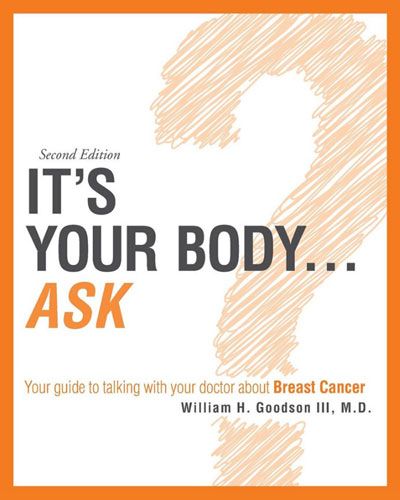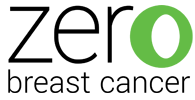It's Your Body... Ask: Your Guide to Talking With Your Doctor About Breast Cancer

Overview
This book fills an important gap in the growing collection of breast cancer books published in the last few years. It does so for several reasons. It has been written by a very experienced breast cancer doctor who brings significant empathy to the work i.e Dr. Goodson puts himself in the shoes of the lay person coming to grips with the complicated and complex world of breast health and breast disease. He imparts information that encourages, facilitates and supports effective exchanges between doctor and patient, family members or other non-medical interested parties. He translates important and tricky concepts on how to evaluate possible risk factors. The book effectively explains biology when necessary but isn’t a comprehensive text book on breast anatomy or physiology. The book provided a clear overview of various clinical tests and how these are interpreted in order to determine an accurate and personalized breast cancer diagnosis. It surveys treatment options and how to bring critical thinking to decision-making where choices exist. Dr. Goodson calmly and rationally examines how medical bias may be a concern that patients should be aware of. He educates the reader on what what progress has been made in combating this disease while honestly acknowledges what is still unknown.
How the book is organized
The book is organized into an Introduction followed by three additional sections. The first covers the questions that a healthy person might want to ask to be sure they are aware and prepared in the even of breast problems; the second covers questions you might want to ask if you or your medical care provider are concerned you may have disease in your breast; finally the third section covers the questions to ask if you have a breast cancer diagnosis.
Introduction
The Introduction to the book clearly explains how to evaluate the quality and value of the answers you receive to your questions by helping you understand the different sources of information and how reliable they are – or are not. In doing so Dr. Goodson also provides a key to ensure that the reader understands the source and quality of the information he is sharing in the book.
Part One
This section focuses in most detail on questions about the types of screening as well as the relative and absolute benefit of screening. Dr. Goodson unpacks the technology and explains the research on outcomes of different screening techniques. He also examines who benefits most from what kind of screening based on their age and possible inherited, or other, risk factors. He lays out some of the seemingly contradictory recommendation vis a vis mammograms, clinical breast example and self examination in a particularly clear way. He looks at the issue of hormones – naturally occurring in the body or prescribed by your health care provider. By doing so he helps the reader understand the importance of certain questions and guides them on how to ask the questions clearly and distinctly. When a lay person and a medically trained person can find the right common vocabulary for a conversation the transfer of knowledge from the expert to the person asking the questions has the best chance of happening effectively.
Part Two
In a sense this section deals with someone who has become aware – either through their own monitoring of their own body or through a routine screening or other doctor visit – that something might be amiss. It’s a fairy short section that strikes a good balance between supporting the importance of exploring anything usual or ‘abnormal’ without being alarmist. It serves to encourage people not to trivialize or ignore the unusual but to err on the side of caution and only rule out any serious problems after investigating the concerns thoroughly.
Part Three
Receiving a breast cancer diagnosis is at the very least disorienting and very often stressful. Dr. Goodson’s approach is that of a ‘knowledge’ coach. He moves through the explanations of how the diagnosis is arrived at, what the terminology means and what the implications may be for the short-term, medium term and long term prognosis (outcome) for the patient. This includes explanations on the possibilities of future cancers in the same or the unaffected breast and metastatic disease (when they cancer has spread from the breast to bones, lungs, brain, liver and other organs). Once that information is understood the reader then has a basis to understand the material on how to think through key decisions around surgery, radiation, chemotherapy, hormone therapy and adjuvant therapy. Dr. Goodson also briefly touches on issues of follow up screening to stay ahead of possible recurrences or spread of the disease.
Conclusion and Recommendation
We did wonder what Dr. Goodson might have written on the topic of Vitamin D in supporting breast health – he does address vitamins A, C and E briefly. We also noted that ovary removal (oophorectomy) as a breast cancer risk-reducing strategy in very high risk but still disease free women was not directly mentioned although he does address ovary removal as a possible strategy once an estrogen + breast cancer has been diagnosed. The summary of major breast cancer trials is appreciated and the glossary of terms is very helpful. An index would have been beneficial too.
We do recommend this simple straightforward, but not simplistic, easy to use book for anyone who is about to have conversations with health care professionals about their breast health. We do note that you still need a post high school/college undergraduate reading level to be able to fully benefit from this book. We also note that the book only touches briefly on psycho-social, family and economic issues that breast health issues can entail. That is another book in its own rights no doubt.
This book is 134 pages.
Low cost Kindle version available here!
Book Reviewed by Rose Barlow, ED Zero Breast Cancer.

